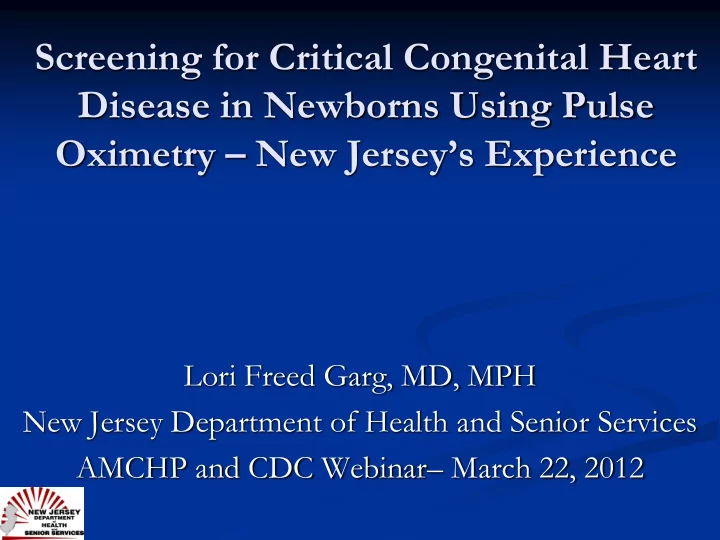

Screening for Critical Congenital Heart Disease in Newborns Using Pulse Oximetry – New Jersey’s Experience Lori Freed Garg, MD, MPH New Jersey Department of Health and Senior Services AMCHP and CDC Webinar – March 22, 2012
Pulse Oximetry Screening Legislation P.L. 2011, Chapter 74 “The Commissioner of Health and Senior Services shall require each birthing facility licensed by the Department of Health and Senior Services to perform a pulse oximetry screening, a minimum of 24 hours after birth, on every newborn in its care.” -Signed June 2, 2011 -Effective Date -August 31, 2011 90 days after enactment -Unfunded Mandate
Implementation- Define Role of NJDHSS Mandated to screen, not how to screen Point of care test Hospitals responsible for ensuring follow up, not NJDHSS No active follow up as with biochemical NBS Divisional Responsibilities Division of Licensing Oversight of hospital compliance with legislation Newborn Screening Program Initial charge to develop Best Practices Guidelines Expanded to support and guide implementation efforts to build an effective screening & surveillance program
Implementation – Establish Partners Identified pulse ox contacts at each birthing facility Convened Critical Congenital Heart Disease Screening Working Group Initial focus to develop recommended screening protocol Two in-person meetings Extensive correspondence (email and conference calls)
Education/Training Distributed Protocols Conducted 2 webinars Frequent communication with hospitals More intensive efforts planned (pending resources) Best Practices Guidelines Development of parent education handout Train the trainer model for nursing education Standardized slide deck for physicians conferences at each hospital
Surveillance Short Term Plan: Quarterly aggregate data # births # screened Birth Defects Registry – all failed screens Screen results, results of evaluation, prenatal history, history of symptoms… Long Term Plan Electronic Birth Reporting System Birth Defects Registry
Aggregate Data Questions Number of Live Births Number Screened Explain discrepancies – expired, transferred in/out, not medically appropriate, not 24 hours, born in prior reporting period, Number of Failed Screens
BDR Follow-up Questions Location at time of screen Cardiac consult prior to screen Date and time of screen Prenatal ultrasound (date Readings (UE and LE) x 3 and result) Postnatal echo (date and Baby asx at time of pulse ox result) (if no, list sxs) Transfer (where and Screen in response to sxs or when) routine screen Final diagnosis explaining failed screen
Sample Log
PRELIMINARY DATA
Data Sources Initial Survey re: Infrastructure August 4, 2011 Hospital Survey November 2011 25/52 responded Informal feedback from hospitals CDC interviews at birthing facilities Epi-Aid : 11 birthing facilities Econ-Aid: 7 birthing facilities Quarterly Aggregate Data Reports Birth Defects Registry
Infrastructure: Availability of Pediatric Echos Hospital Survey- August, 4, 2011 Does your facility have the ability to do an echocardiogram on site (by someone with expertise in conducting echocardiograms in newborns)?
Hospital Feedback on the Process Documentation “Very difficult to keep accurate log as our EMR cannot provide report…” Short implementation time “ Issues were with turnaround time from receiving the screening protocol from NJDHSS and implementation of the program.” Cost “Costly - had to purchase additional pulse oximetrer, as well as reusuable probes, that require a "disposable" wrap that was not budgeted for.” Most stated no significant issues “The implementation has gone smoothly. No particular challenges.” Majority utilizing NJDHSS protocol
Challenges Overall 90 day implementation period Unfunded mandate/limited staffing resources Inclusion of all infants (NICU too) Education Need for more intensive training Need for educational materials Surveillance system Accuracy of data — steep learning curve Aggregate data Quality assurance
Strengths >95% of infants screened in first 90 days Mechanism to collect data for program evaluation Covered a lot of ground with very limited resources--both financial and staff Committed working group, dedicated staff and established connections with birthing facilities
“It is because of your law that our son’s life was saved, and my husband and I are very grateful to you…” Letter to Governor Christie from the family of Dylan Gordon
Acknowledgements Pulse Ox Core Team at the NJDHSS CDC Collaborators CCHD Screening Working Group 54 New Jersey Hospitals
Contact Information: Lori Freed Garg, MD, MPH Medical Director Newborn Screening and Genetic Services Program New Jersey Department of Health and Senior Services Lori.Garg@doh.state.nj.us
Recommend
More recommend